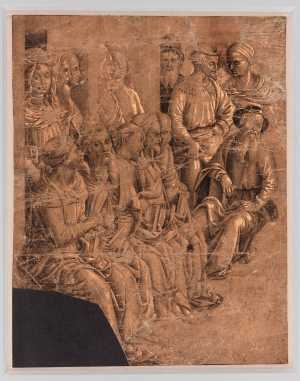Specifications
| Title | Group of Seated and Standing Men, after a Lost Fresco in San Marco, Rome |
|---|---|
| Material and technique | Metalpoint, pen and brush and brown ink, heightened with white, on prepared paper |
| Object type |
Drawing
> Two-dimensional object
> Art object
|
| Location | This object is in storage |
| Dimensions |
Height 247 mm Width 199 mm |
|---|---|
| Artists |
:
Perugino (Pietro di Cristoforo Vannucci)
: Pinturicchio (Bernardo di Betto di Biagio) : Anoniem |
| Accession number | I 473 recto (PK) |
| Credits | Loan Stichting Museum Boijmans Van Beuningen (former Koenigs collection), 1940 |
| Department | Drawings & Prints |
| Acquisition date | 1940 |
| Creation date | in circa 1480-1530 |
| Watermark | not possible to determine through prepared ground on both sides (vV, ?P) |
| Inscriptions | '17' (removed mount, below left, pen and brown ink), 'Masaccio' (removed mount, lower centre, pen and brown ink), ‘60’ (removed mount, above left, pencil), ‘72’ (verso of removed mount, above centre, pencil), ‘G. 51’ (verso removed mount, above centre, pen and black ink), 'T. Kerrich / M. C. C / septr. 1788.' (verso of removed mount, centre, pen and brown ink) |
| Collector | Collector / Franz Koenigs |
| Mark | Th. Kerrich (L.2443 deest), F.W. Koenigs (L.1023a deest) |
| Provenance | Rev. Thomas Kerrich (1748-1828, L.2443)****, Cambridge; - ; Art dealer Julius W. Böhler (1883-1966), Lucerne; Franz W. Koenigs (1881-1941, L.1023a), Haarlem, acquired in 1929 (Umbrian School, mid-15th century); D.G. van Beuningen (1877-1955), Rotterdam, acquired with the Koenigs Collection in 1940 and donated to Stichting Museum Boijmans Van Beuningen |
| Research |
Show research Italian Drawings 1400-1600 |
| Material | |
| Object | |
| Technique |
Prepare
> Prepared
> Shaping techniques
> General technique
> Technique
> Material and technique
Prepare
> Prepared
> Shaping techniques
> General technique
> Technique
> Material and technique
Highlight
> Painting technique
> Technique
> Material and technique
|
| Geographical origin | Italy > Southern Europe > Europe |
| Place of manufacture | Umbria > Italy > Southern Europe > Europe |
Do you have corrections or additional information about this work? Please, send us a message

























